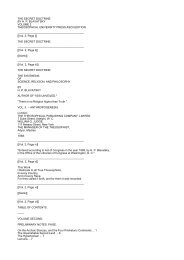You also want an ePaper? Increase the reach of your titles
YUMPU automatically turns print PDFs into web optimized ePapers that Google loves.
The Doctrine Of Eternal Life.<br />
<strong>the</strong> form <strong>of</strong> <strong>the</strong> uræi [which] are on thy brow.[8]<br />
[1. I.e., <strong>the</strong> soul <strong>of</strong> <strong>the</strong> gods.<br />
2 Recueil de Travaux, t. iv., p. 61 (l. 522).<br />
3 Recueil de Travaux, t. v-, p. 55 (l. 350), and see Pepi I., ll. 19, 20.<br />
4 Ibid., t. v., p. 16o (l. 13). 5 Recueil de Travaux, t. v., p. 175 0. 113).<br />
6 Ibid., t. v., p. 183 (l. 166).<br />
7 I.e., <strong>the</strong> Eye <strong>of</strong> Horus.<br />
8 Ibid., t. v., p. 184 (l. 167).]<br />
{p. lxvi}<br />
8. ha Pepi pen ba-k baiu Annu as ba-k baiu<br />
Behold Pepi this, thy soul is <strong>the</strong> soul <strong>of</strong> Annu; behold thy soul is <strong>the</strong> soul<br />
Nexen as ba-k baiu Pe as ba-k seb anx as<br />
<strong>of</strong> Nekhen; behold thy soul is <strong>the</strong> soul <strong>of</strong> Pe; behold thy soul is a star living, behold,<br />
xent senu-f<br />
among its brethren.[1]<br />
The khaibit or shadow.<br />
In connection with <strong>the</strong> ka and ba must be mentioned <strong>the</strong> khaibit or shadow <strong>of</strong> <strong>the</strong> man, which <strong>the</strong><br />
Egyptians regarded as a part <strong>of</strong> <strong>the</strong> human economy. It may be compared with <strong>the</strong> {Greek skia'} and<br />
umbra <strong>of</strong> <strong>the</strong> Greeks and Romans. It was supposed to have an entirely independent existence and to be<br />
able to separate itself from <strong>the</strong> body; it was free to move wherever it pleased, and, like <strong>the</strong> ka and ba, it<br />
partook <strong>of</strong> <strong>the</strong> funeral <strong>of</strong>ferings in <strong>the</strong> tomb, which it visited at will. The mention <strong>of</strong> <strong>the</strong> shade, whe<strong>the</strong>r <strong>of</strong><br />
a god or man, in <strong>the</strong> pyramid texts is unfrequent, and it is not easy to ascertain what views were held<br />
concerning it; but from <strong>the</strong> passage in <strong>the</strong> text <strong>of</strong> Unas,[2] where it is mentioned toge<strong>the</strong>r with <strong>the</strong> souls<br />
and spirits and bones <strong>of</strong> <strong>the</strong> gods, it is evident that already at that early date its position in relation to man<br />
was well defined. From <strong>the</strong> collection <strong>of</strong> illustrations which Dr. Birch appended to his paper On <strong>the</strong><br />
Shade or Shadow <strong>of</strong> <strong>the</strong> <strong>Dead</strong>,[3] it is quite clear that in later times at least <strong>the</strong> shadow was always<br />
associated with <strong>the</strong> soul and was believed to be always near it; and this view is<br />
[1. Recueil de Travaux, t. v., p. 184 (l. 168).<br />
2. Recueil de Travaux, p.62 (l. 523).<br />
3. See Trans. Soc. Bibl. Arch., vol. viii., p. 386-97.]<br />
{p. lxvii}<br />
supported by a passage in <strong>the</strong> XCIInd Chapter <strong>of</strong> <strong>the</strong> <strong>Book</strong> <strong>of</strong> <strong>the</strong> <strong>Dead</strong>,[1] where it is said:--<br />
em xena ba-a sauti xaibit-a un uat<br />
http://www.sacred-texts.com/egy/ebod/ebod05.htm (9 <strong>of</strong> 21) [8/10/2001 11:23:21 AM]

















